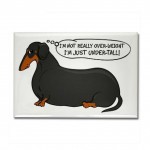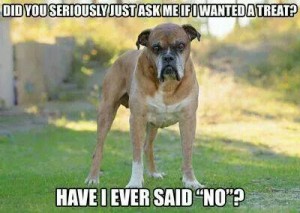 Obesity rates in humans have reached alarming levels. It is estimated that 64% of U.S adults are overweight or obese. Our canine friends are not far behind. The estimates for dogs are 25-40% and climbing. Lifestyles have been changed with the advances in electronic technology. Time that used to be spent outdoors is now spent indoors in a “virtual” reality. Most dogs are forced to rely on 1 hour or less of vigorous exercise a day. Many spend hours locked in crates while their owners are at work. This lack of exercise for both humans and our furry companions plays a big part in the obesity problem.
Obesity rates in humans have reached alarming levels. It is estimated that 64% of U.S adults are overweight or obese. Our canine friends are not far behind. The estimates for dogs are 25-40% and climbing. Lifestyles have been changed with the advances in electronic technology. Time that used to be spent outdoors is now spent indoors in a “virtual” reality. Most dogs are forced to rely on 1 hour or less of vigorous exercise a day. Many spend hours locked in crates while their owners are at work. This lack of exercise for both humans and our furry companions plays a big part in the obesity problem.
Poor diet is another major contributing factor. Poor quality food, weather it is for humans or dogs, is all considered “fast food”. Many people equate food with love. We all feel good if we can feed something. Petting zoos are successful because people have the “need to feed”. People that over feed their dogs are, literally, killing their dog’s with kindness. Unless someone points this out to them, most people don’t recognize the problem until serious health issues arise.
Testing can be done to rule out any possible medical reasons for the weight gain such as a thyroid condition. If all medical conditions are ruled out, the most common causes are:
- High Carbohydrate Diet-Usually corn based
- TREATS-TREATS-TREATS
- Lack of Exercise
Lets address these common causes one by one.
1. Carbohydrates are poorly utilized by the dog. All the extra energy from those carbohydrates is stored as fat. High carbohydrate foods are considered the “fast foods” of the dog food market. A better alternative is a high protein, low carbohydrate, reduced fat diet. They are available in kibbled, canned, dehydrated or frozen raw formulas. The volume of the dog’s ration should also be reduced. To make the dog feel fuller, vegetables such as green beans and canned pumpkin can be added to make the dog feel satisfied without adding extra calories. Veterinary formulas that are prescribed for overweight dogs are usually low fat, high fiber formulas. They are not recommended for long term use because of the low quality of their ingredients.
2. Treat Limits – Many people over-treat their dogs. Instead of being rewarded for DOING something, dogs are treated for just BEING. It becomes a routine for people to treat the dog at certain times throughout the day. The dog becomes conditioned to receive the treats and will harass the owner or stare at the area the treats are kept. Fortunately, dogs can be conditioned into and out of anything. The hard part is changing the owner. One large wheat based biscuit contains 500 calories. One small wheat based biscuit is equivalent to 1 hamburger for 20lb dog. That is a meals worth of calories. Eventually it is going to catch up! The treats don’t have to be eliminated completely, but can be limited in quantity and changed to a treat that is better for the dog. Carbohydrate based treats such as biscuits should be substituted with meat based treats or real meat. Freeze dried chicken breast is an easy, low calorie, treat. Real meat can be cut into small cubes and frozen individually on a cookie sheet. They can be kept in a bag in the freezer to be used at any time. Frozen vegetables such as green beans, peas or broccoli make great low calorie treats as well. Fresh or frozen asparagus spears are a great chew stick for little dogs. They love them and they are good for them.
dogs can be conditioned into and out of anything. The hard part is changing the owner. One large wheat based biscuit contains 500 calories. One small wheat based biscuit is equivalent to 1 hamburger for 20lb dog. That is a meals worth of calories. Eventually it is going to catch up! The treats don’t have to be eliminated completely, but can be limited in quantity and changed to a treat that is better for the dog. Carbohydrate based treats such as biscuits should be substituted with meat based treats or real meat. Freeze dried chicken breast is an easy, low calorie, treat. Real meat can be cut into small cubes and frozen individually on a cookie sheet. They can be kept in a bag in the freezer to be used at any time. Frozen vegetables such as green beans, peas or broccoli make great low calorie treats as well. Fresh or frozen asparagus spears are a great chew stick for little dogs. They love them and they are good for them.
3. Exercise – This is by far the hardest part of the weight loss equation. People either don’t have time to exercise the dog, are not physically able to exercise the dog or plain just don’t WANT to exercise the dog. Unfortunately, diet change can only work to a point. If the dog needs to lose a large amount of weight, diet change alone is not going to achieve the goal. Exercise is not only good for the dog physically, but mentally as well. Dogs in their natural state walk 10-12 HOURS a day. Domesticated dogs are lucky if they get 45 minutes! Many of unwanted canine behaviors can also be alleviated with regular exercise. Dogs must be conditioned into an exercise program. Start with 10-15 minutes twice a day for an obese dog and add 5 minutes to each walk every other day. For those owners that cannot walk their dogs outside, a treadmill is a great tool also. A trainer can come to their home and train the dog to the treadmill in one session. Aqua-Therapy clinics are also available. Underwater treadmills offer low-strain exercise in a controlled environment. They usually also offer swim tanks. This alternative is excellent for the severely obese dog that has to lose weight quickly, such as in anticipation of surgery or for a dog that is unable to exercise due to arthritis or other orthopedic problems.
Most dogs that need to lose weight will not be able to exercise enough on their own to make a difference. The dog let out in the backyard is not going to move around without prompting from the owner. As we say, “If you see a fat dog, the owner is not getting enough exercise!”
 By taking the steps needed for your dog to lose the weight he needs to, you will be helping him to lead a healthier, much longer life!
By taking the steps needed for your dog to lose the weight he needs to, you will be helping him to lead a healthier, much longer life!
Until next time my faithful furry followers!

This is the best post I have come across
Thanks so much admin